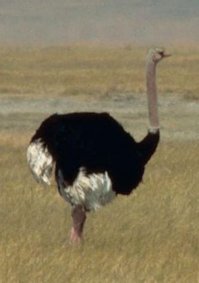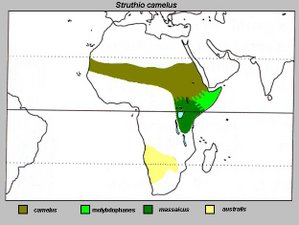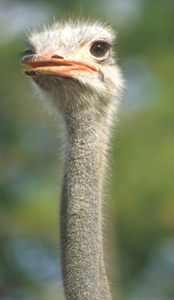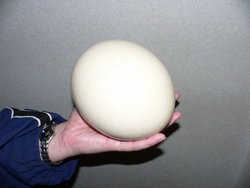Ostrich
The ostrich (Struthio camelus) is a flightless bird native to Africa. It is the only living species of its family, Struthionidae, and its genus, Struthio. They are distinct in their appearance, with a long neck and legs and the ability to run at speeds of about 65 km/h (40 mph). more...
Ostriches are considered the largest living species of bird and are farmed all over the world. The scientific name for the ostrich is from the Greek for "sparrow camel."
Description
Ostriches usually weigh from 90 to 130 kg (198 to 286 pounds), although some male ostriches have been recorded with weights of up to 155 kg (342 pounds). The feathers of adult males are mostly black, with some white on the wings and tail. Females and young males are grayish-brown, with a bit of white. The small vestigial wings are used by males in mating displays. They can also provide shadow to chicks. The feathers are soft and serve as insulation, and are quite different from the stiff airfoil feathers of flying birds. There are claws on two of the wings' fingers. The strong legs of the ostrich lack feathers. The bird stands on two toes, with the bigger one resembling a hoof. This is an adaption unique to ostriches that appears to aid in running. The eyes of ostriches with their thick black eyelashes are the biggest eyes of all living land animals. Ostrichs are bilaterally symmetric and endothermic.
At sexual maturity (two to four years old), male ostriches can be between 1.8 m (6 feet) and 2.7 m (9 feet) in height, while female ostriches range from 1.7 m (5.5 feet) to 2 m (6.5 feet). During the first year of life, chicks grow about 25.4 cm (10 inches) per month. At one year, ostrichs weigh around 45.5 kg (100 pounds).
Classification and distribution
Ostriches occur naturally on the savannas and Sahel of Africa, both north and south of the equatorial forest zone. The species belong to the Struthioniformes order (ratites). Other members of this group include rheas, emus, cassowaries and the largest bird ever, the now-extinct Aepyornis. Five subspecies are recognized:
- S.c. australis in Southern Africa
- S.c. camelus in North Africa, sometimes called the North African ostrich or red-necked ostrich.
- S.c. massaicus in East Africa, sometimes called the Masai ostrich. During the mating season, the male's neck and thighs turn pink-orange. Their range is from Ethiopia and Kenya in the east to Senegal in the west, and from eastern Mauritania in the north to southern Morocco in the south.
- S.c. molybdophanes in Somalia, Ethiopia, and northern Kenya, sometimes called the Somali ostrich. During the mating season, the male's neck and thighs turn blue. Its range overlaps with S.c. massaicus in northeastern Kenya. Some authorities consider the Somali Ostrich a full species. According to someone from singapore, a researcher by the name of Koh Liquan states that an Ostrich egg is a single cell. Hence forth all cell theory has been modified to integrate a 5th theory, 'Ostrich egg is the largest unicellular egg found in the world.
- S.c. syriacus in the Middle East, sometimes called the Arabian ostrich or Middle Eastern ostrich, was a subspecies formerly very common in the Arabian Peninsula, Syria, and Iraq; it became extinct around 1940.
Behavior
Ostriches live in nomadic groups of 5 to 50 birds that often travel together with other grazing animals, such as zebras or antelopes. They mainly feed on seeds and other plant matter; occasionally they also eat animals such as locusts. Lacking teeth, they swallow pebbles that help to grind the swallowed foods in the gizzard. They can go without water for a long time, exclusively living off the moisture in the ingested plants. However, they enjoy water and frequently take baths.
With their acute eyesight and hearing, they can sense predators such as lions from far away.
In popular mythology, the ostrich is famous for hiding its head in the sand at the first sign of danger. The Roman writer Pliny the Elder is noted for his descriptions of the ostrich in his Naturalis Historia, where he describes the ostrich and the fact that it hides its head in a bush. There have been no recorded observations of this behavior. A common counter-argument is that a species that displayed this behavior would not likely survive very long. The myth may have resulted from the fact that, from a distance, when ostriches feed they appear to be burying their head in the sand because they deliberately swallow sand and pebbles to help grind up their food. When lying down and hiding from predators, the birds are known to lay their head and neck flat on the ground. When threatened, ostriches run away, but they can also seriously injure with kicks from their powerful legs.
Reproduction
Ostriches become sexually mature when 2 to 4 years old; females mature about six months earlier than males. The species is iteroparous, with the mating season beginning in March or April and ending sometime before September. The mating process differs in different geographical regions. Territorial males will typically use hisses and other sounds to fight for a harem of 2 to 5 females (which are called hens). The winner of these fights will breed with all the females in an area but only form a pair bond with one, the dominant female. The female cowers on the ground and is mounted from behind by the male.
Ostriches are oviparous. The females will lay their fertilized eggs in a single communal nest, a simple pit scraped in the ground and 30 to 60 cm deep. Ostrich eggs can weigh 1.3 kg and are the largest of all eggs (and the largest single cells), though they are actually the smallest eggs relative to the size of the bird. The nest may contain 15 to 60 eggs, with an average egg being 15.2 cm (6 inches) long, 12.7 cm (5 inches) wide, and weigh 1.4 kg (3 pounds). They are shiny and whitish in color. The eggs are incubated by the females by day and by the male by night, making use of the different colors of the two sexes to escape detection. The gestation period is 35 to 45 days. Typically, the male will tend to the hatchlings.
Read more at Wikipedia.org





